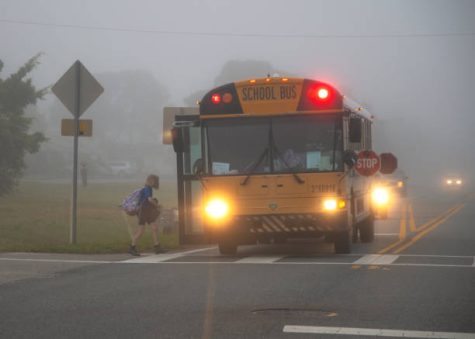BEEP! BEEP! BEEP!
Students’ lack of sleep has gotten less attention since the COVID-19 pandemic, but that doesn’t mean it’s no longer an issue.
March 20, 2023
BEEP! BEEP! BEEP!
It’s 5:30 AM, and all around the NA school district, alarms jolt teens from their dreams. They wake up, contemplate life choices, then groggily crawl out of bed, sometimes eat breakfast , and try to catch the school bus in time.
Sleep deprivation, whether due to late-night homework, anxiety-induced insomnia, or simply an impossible schedule puts North Allegheny high schoolers at serious risks for serious, long-lasting effects on health, safety, and academic performance. In fact, according to the National Library of Medicine, not only is academic performance negatively affected, but sleep deprivation also leads to agitation, irritability, and an inability to concentrate on any tasks at hand. The solution is clearer than one may think: pushing back school start times.
A survey conducted of students at NAI showed that, with NASD’s current 7:23 AM high school start time, over 90% of a sample of NAI high school students are not getting sufficient sleep. Though to some, starting school at 7AM may seem doable, many school buses arrive to students’ stops before 6:30AM.
For some, taking the bus is the only option.
One sophomore stated, “My school bus comes at 6:05, so I have to wake up even earlier before then. My family isn’t able to drive me to school in the morning, so it’s basically my only choice.” They also described the struggles of getting enough rest to feel alert and awake throughout the day.

In fact, according to the survey, 94.7% of students reported feeling exhaustion or fatigue throughout the day, as well as feeling inadequately rested in the morning.
And that is only the beginning.
Nearly half of survey participants reported having trouble falling asleep at night, due to stress and schoolwork. Combined with NASD’s early start time, this is bound to lead to disaster.
“Honestly, sometimes the thought of not getting enough sleep, and having to get up early keeps me awake at night,” another student said, “It’s really not helped by all of my crazy homework assignments either.”
For student athletes, an even later school start time is crucial. Grace Thomas, a sophomore on the NA Rowing Team, reported, “I have rowing every evening from 4-8 (including transport time), and I’m usually really really sore from that, so when I don’t get enough sleep, it’s always incredibly hard to wake up in time to catch the bus.”
Nearly 45% of surveyed students report falling asleep in class as something common, and nearly 80% of students’ mental/emotional/physical health, and academic performance be negatively affected by sleep deprivation.
Thus, the solution is clearer than it ever has been: NASD high school start times must be pushed back to ensure the physical, emotional, mental, and academic wellbeing of North Allegheny’s high school students. As a school community and district which prepares all students for success in a changing world, students clearly cannot be prepared if they are worn out from exhaustion from a problem with such a clear solution.
It is also important to recognize that the sleep deprivation of NA students is not the fault of their own time management, but rather the difficult schedule which school start times pose. Its lasting effects reach far into students’ academic performance, which is an extreme concern: teens are students first.
However, the question remains: how? The following solutions have been tendered.
- Switching start times for middle and high schools
- For the typical student, middle school takes place for the least amount of years (3). Even if the earlier start time may pose a challenge, elementary and high school are both sustained for much longer periods of time (5 years, and 4 years).
- According to experts in the National Library of Medicine, “Circadian rhythms are physical, mental, and behavioral changes that follow a 24-hour cycle.” These may be different for everyone, but is most influential in teens’ later circadian rhythms and early school schedules. In fact, the “Big Dip” in teens’ circadian rhythm occurs from 3AM to 7AM – the latter of which is a prime school hour.
- Furthermore UCLA Health states that in middle school & before puberty, childrens’ and tweens’ circadian rhythms are naturally earlier. Thus, it would be considerably an easier transition process for middle or even elementary schoolers, than for high school teens.
- In high school, many student athletes also begin competing seriously in sports, extracurriculars, and academics, in competition for college athletics, and their very near future of higher education/any other choice after high school. Sleep is even more crucial during this time; an example: “flunking” a high school final or midterm due to inadequate sleep and concentration is much more significant than “flunking” a middle or elementary school quiz or test.
- Increasing the NA transportation budget (more buses)
- As of the 2023-2024 school year, the North Allegheny General Fund Budget, as well as the local Pittsburgh newspaper shows that the district will “save money by purchasing six, 84-passenger buses… according to the presentation… saved about $75,000 on the $797,000 purchase… The district plans to spend more than $1.5 million for information technology in 2023-2024.”
- With these numbers, it is evident that it is indeed possible, if only in the slightest, to put more of the NA budget towards buying buses that can transport high school students to school at a later time, instead of running 3 rounds of buses (for elementary and middle school, with high school being the earliest).
Lastly, students at NAI are actively voicing their dissent at the current 7:23 AM school start time.
“I feel school starts way too early,” a sophomore states. “During the summer I don’t need to use melatonin as much to be able to get enough sleep to function. I have had to quit my sport because most of the practices were later in the evening, so I couldn’t get enough sleep and do them at the same time.”
Another sophomore states, “[When] you don’t get enough sleep for months and months on end, it really shows in your performance. I don’t have the energy during school to actually do work and pay attention, I find myself just closing my eyes or just staring off into space tuning out everything around me.”
Two students voice it perfectly: “Once people recognize the negative effects of sleep deprivation, it is doable to change the system…” “…“I understand the challenges it may pose but later start times would be extremely beneficial.”

School sports have been a recurring theme, in the subject of school start times. “…as a person who plays a water sport, practices are mainly before school. And because it is before school, I have adapted to a regular schedule of waking up at 4 to go to practice at 5 in the morning. This still applies even out of season with less morning practices. I find myself waking up naturally between 3:30 and 4am all the time which is not something that any person would think is healthy/normal. If school starting times were pushed back, then I could actually adjust to a normal waking time and get extra sleep.” The list of reasons goes on.
Sadly, the North Allegheny School District has never polled or surveyed their own students as a whole. Whether it be end-of-year surveys, beginning-of-year polls, or mental health forms, the issue of sleep is mentioned few and far between. In fact, in December 2017, during a school start time survey, students were not polled at all. Instead, links were indirectly sent to parents, consequently giving the student body very little say in the school schedule which runs their very lives.
Thus–whatever the solution may be, it is crucial that there be change, and that there be change now.











Jackson • Mar 20, 2023 at 8:58 am
Finally, someone is bringing attention to students’ sleep schedules at our schools. School is hard enough as it is but doing it on 4 or 5 hours of sleep makes it even harder. Great article, Hallie!
Hallie • Apr 7, 2023 at 6:12 pm
Thank you, Jackson! I’m glad you enjoyed it. I truly believe that lack of sleep, and the anxiety many students have surrounding it is a huge contributor to multiple facets of students’ wellbeing in the academic, social, and physical realms of education.